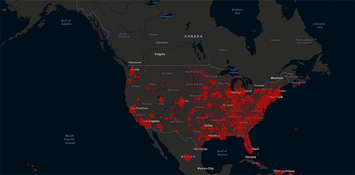
The last thing this polarized Republic needs is, well, more polarization, but that is what we are contracting from the pandemic. Americans, irrespective of region, broadly want the same things, such as safety, a return to normalcy, and an end to dependence on China for medical supplies, but they differ in the depth of their experiences with the pandemic.
Rather than rallying the nation, COVID-19 has amplified every fissure in this society from class to race, but perhaps most of all regarding geography. This reflects, in large part, the different experiences felt in various localities and the differences in how economies function from region to region.
On one hand there is the New York City urban area, which has suffered roughly 40 percent of fatalities, and bore the brunt of the crisis. Places outside New York with the most deaths have been central cities such as New Orleans and Detroit, where the vast majority of deaths have been endured by African Americans living in crowded, low income districts.
In past circumstances (after 9/11 or Hurricane Katrina), Americans responded with their customary generosity. New Yorkers, in particular, were seen as heroic, and for a short while Rudy Giuliani, hard as it is to believe now, was “America’s Mayor.” Not this time. Only a person just arrived from Mars would see New York Mayor Bill De Blasio as an inspiring figure, although his nemesis, Andrew Cuomo, has gained some national street cred.
The polarized reaction to the pandemic reflects already established patterns of partisan group-think, particularly in the dominant mainstream media. In early times a pandemic would inspire a surge of unity akin to 9/11 among Americans — even journalists. But the never-ending battle between bombastic narcissist Donald Trump and the equally self-indulgent media seemingly allows for no such genuflection to national interest.
Viral Geography
To the political divide, add a major geographic one. Huge parts of the country have been barely impacted by the virus but almost everywhere has been hit by the lockdowns and social distancing policies. Not surprisingly, extending lockdown orders seems far less compelling in places where the pandemic’s impact has, so far, been minimal.
This pattern of infection and fatalities almost completely parallels that of our political divides, with the generally GOP dominated countryside least impacted, the suburbs only somewhat so, and the big blue cities bearing the bulk of pain. By one estimate, states with Republican governors, mostly in the South, Intermountain West, and the Great Plains have suffered one-third the rate of fatalities seen in Democratic controlled states, which tend to be denser in their settlement patterns.
Read the rest of this piece at Daily Caller.
Joel Kotkin is the author of the just-released book The Coming of Neo-Feudalism: A Warning to the Global Middle Class. He is the Presidential Fellow in Urban Futures at Chapman University and Executive Director for Urban Reform Institute — formerly the Center for Opportunity Urbanism. Learn more at joelkotkin.com and follow him on Twitter @joelkotkin
Photo credit: screenshot from COVID-19 CSSE Dashboard Johns Hopkins.












